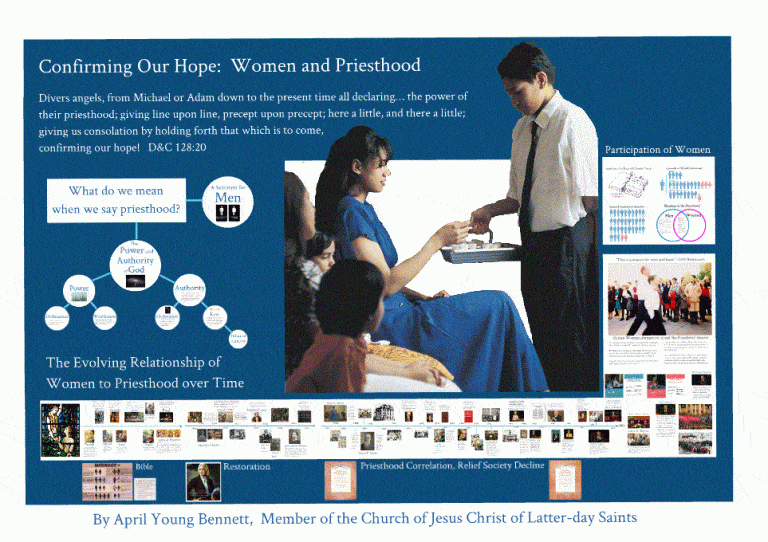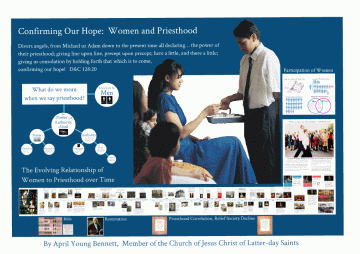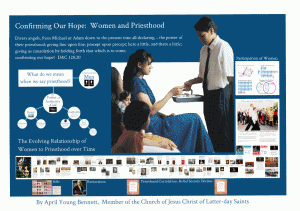Earlier this month, I presented at Counterpoint Conference on the topic, Theological Foundations: What Is Priesthood And Why Is It Necessary For Women? Here is my presentation.
YouTube Version
Prezi Version
(No narration, but crystal clear viewing of graphics and text)
Full Text
In Doctrine and Covenants 128, Joseph Smith expressed his joy in the restoration of the priesthood, line upon line, precept upon precept, here a little and there a little, confirming his hope. 1 Within the church he established, women are still hoping that the priesthood will be restored to us. Does Mormon theology confirm our hope?
The Bible describes four female prophets: Miriam 2, Deborah 3, Huldah 4 and Anna 5. However, the LDS Guide to the Scriptures states that female prophets did not hold the priesthood or its keys. 6 The guide offers no scriptural reference to support this assumption because there is no scripture banning women from the priesthood. In the most recent general conference, Elder Andersen answered the question, “Why are the ordinances of the priesthood administered by men?” by citing 1 Nephi 11: 17: “I do not know the meaning of all things.” 7 8
Regardless of whether biblical women had the priesthood, it is important to remember that the Bible is an historical document that reflects the culture of its time. The Bible condoned many practices, including the oppression of women, that society has sought to abandon as culture has advanced “line upon line, precept upon precept.” 1
The restoration of the gospel also took place within a social context that was hostile toward women.
Women were forbidden from speaking publicly in the presence of men or participating in government at all. Laws treated women as property of their husbands. 9 The church was restored by an all-male group 6 years before Angelina and Sarah Grimke broke cultural taboos by publicly speaking about abolition. Mobs were so enraged by Grimke’s persistent choice to speak in public before mixed gender and mixed racial groups that they burned down Pennsylvania Hall when Grimke spoke there in 1838. 10 It wasn’t until 1848 that Elizabeth Cady Stanton sponsored the first women’s rights convention, promoting the radical new idea that women should vote. 11 But even Stanton was not so radical as to consider that women might preside over the convention they had planned. Stanton was shocked when Abigail Bush presided over another woman’s rights convention a few weeks later. 12 The first Protestant woman ordained to the priesthood was Antoinette Brown, 23 years after the LDS church was established. 13
Nineteenth century Americans looked to the writings of Paul to support the exclusion of women from religious and secular governance. 13 14 15 However, Brown pointed out that Paul himself supported women with priesthood, such as Phoebe the deacon and Junia the apostle. 13 16 17 Joseph Smith shared Brown’s views that women of Paul’s day had the priesthood. When the Relief Society was established in 1842, he promised to make the Relief Society a kingdom of priests as in Enoch’s day or Paul’s day. 18 Other than Smith’s statements, we do not know much about women in the city of Enoch, but we do know that the Melchizedek priesthood was on the earth at that time and that Enoch’s people succeeded in establishing Zion on earth. 19 20
Priesthood authority is distributed through ordination and keys. 21 22 23 While Smith complied with the social norms of his time by excluding women from participating in quorums with men, he conferred keys on women within their own gender-segregated Society. He oversaw the ordinations of Elizabeth Whitney and Sarah Cleveland. Explaining that Emma Smith had already been ordained previously, he gave her a blessing analogous to the modern LDS ritual of setting apart. Armed with authority through keys and ordination, the women were instructed to choose their own leaders to govern them. Joseph Smith would instruct them from time to time, but only at the request of the sisters. 18 Compare the autonomy of the Nauvoo Relief Society to more recent protocols, which require male priesthood holder approval of all Relief Society activities and staff. 24
Only two years after the Relief Society was established, Joseph Smith died. His successor, Brigham Young, disbanded the Relief Society. 25 In 1854, the official history of the church changed important passages from the Nauvoo Relief Society minutes about women and priesthood. 25 26 These incorrect transcriptions were quoted for well over 100 years until the Joseph Smith papers project made the original minutes publicly accessible.
In 1867, 22 years after disbanding the Relief Society, Brigham Young decided to create a new Relief Society. He did not give the new Relief Society keys or ordain the women, but the women did receive priesthood power through temple ordinances. With the formal authority of the priesthood lost to women, women became auxiliary to the priesthood. They depended on delegated authority from male priesthood leaders with keys who selected Relief Society officers.
Brigham Young chose to delegate a large amount of authority to the women, opening a wide and extensive sphere of action to them. 27 In spite of its auxiliary status, the Relief Society during this period was the most powerful it has ever been. The Relief Society maintained its own real estate and managed its own finances, ran its own publications, supported political activities such as suffrage, ran economic and agricultural programs like the silk worm project and the grain storage program as well as medical, welfare and social work programs, and supervised the Young Ladies Retrenchment Association and Primary programs. 28 In addition to performing ordinances within temple walls, Snow encouraged women to perform healings by laying on of hands and washing and anointing ceremonies for pregnant women, an ordinance that has been lost to the modern church. 29
In 1906, Joseph F. Smith began a priesthood correlation program, with the goal that there would not be so much necessity for work by auxiliary organizations because it would be done by the regular quorum of the priesthood. 30 At the time, the Relief Society was several years into a fund-raising campaign to build a General Relief Society building. One of the first actions of the correlation program was to give the lot designated for the Relief Society building to the presiding bishopric and to require the Relief Society to hand over its building fund to them to build a Bishop’s building. The Relief Society had raised 70% of the funds needed to meet its goal when they were required to give the money away. 31 The Relief Society moved into the Bishop’s building and the presiding bishopric began supervising Relief Society efforts. 32
In 1918, the presiding Bishopric sold the entire Relief Society grain storage supply, the work of several decades, to the United States government without Relief Society permission. Going forward, the Relief Society had to get permission from the presiding Bishopric to use funds resulting from the sale of their own grain. 33 Priesthood leaders gradually removed authority from women to conduct ordinance work outside the Temple until Joseph Fielding Smith completely ended the practice in 1946. 29
Another correlation effort began in 1962, when Harold B Lee announced his intention to place the priesthood of God at the center and core of the church. 34 Through this new effort, the Relief Society lost its own magazine, its health and social services programs were incorporated into the church welfare system under the direction of the presiding bishopric, its assets were transferred to the First Presidency, and it lost the right to make its own curriculum. 35 36 37 38 The Relief Society gained access to tithing funds, but not authority to govern these funds. 38 Women were banned from serving as stake auditors in 2010, eliminating the last position of financial authority open to women since the Relief Society lost its financial autonomy in 1978. 39
Although correlation cost the Relief Society its autonomy to govern its own programs, it also brought the Council system, which provided opportunities for some women to participate in the holistic governance of the church, integrated with male priesthood holders. When General Relief Society President Barbara Smith announced the Council system, she pointed out that only a few women would be included in these councils. 40 In contrast, more recent statements by church leaders tend to promote councils as highly inclusive of women, such as this recent statement by Elder Ballard: “Much of the leadership is provided by the sisters…Participation of women in ward and stake councils and in the general councils at church headquarters provide…balance.” 41
The gender distribution of councils of the church is mandated by church policy, with men outnumbering and outranking women. 42 An even smaller ratio of women is allowed to read the complete volumes of church policy. 39 43 Since women may not read church policy, it is safe to assume that women are not writing the policies of the church. The influence of women on church doctrine is limited by the small ratio of female speakers at general conferences. 44 The blessings of the priesthood are often described as equal for men and women, and most ordinances and blessings are available to both. However, men have much greater access to the blessings of priesthood service, such as personal growth opportunities. 45
As priesthood correlation eliminated opportunities for women in favor of opportunities for men, the priesthood became almost synonymous with manhood. Hence the oft-repeated critique that women who want to participate fully in the church as priesthood holders just want to be men. Actually, the priesthood is without father or mother or maleness or femaleness. 46 47 Using priesthood as a synonym for men leads to dangerous doublespeak, in which statements like, “The priesthood should govern the church” are interpreted as “Men should govern the church.” 48 This confusing rhetoric continues today. When women who favor ordination sought to attend the recent Priesthood Session of General Conference, they were told that the session was for men and boys. Males who were not even members of the church were welcomed to the session, while women who had been endowed with priesthood power in the temple were not admitted. 49 50
A philosophy that encourages equating priesthood with manhood is the idea that motherhood is a calling that is complementary to and precluding of priesthood. This idea was popularized by a book published in 1954, around the same time that secular American culture was promoting motherhood as an all-encompassing activity that precluded other life pursuits. 51 52 However, women are not given authority even within their own homes as mothers. In the 1970s, the church distributed a pamphlet that promoted fathers’ authority in the home and disempowered women to even preside over family home evenings or prayers. 53 Instead, mothers were expected to nag their husbands to perform this duty they might have done themselves. In 1995, the Proclamation on the Family was presented at a General Relief Society Meeting even though the General Relief Society presidency was offered no opportunity to participate in drafting it. 37 It codified fathers as president of the home while paradoxically stating that mothers are equal partners. 54 Another obvious problem with this parallel is that all men in the church are offered the opportunity to become priesthood holders while motherhood is dependent on relationship status and biological capacity. Sheri Dew attempted to address this problem in 2001 with yet another rhetorical change, describing motherhood as a synonym for womanhood. 55
Since Mormon women organized in 2013 to advocate for the ordination of women, there has been a renewed interest in the relationship between priesthood and women. The first statement issued by the LDS Newsroom in response to Ordain Women stated that the Church follows the pattern set by Jesus for priesthood ordination. 56 According to the four gospels included in our Bible, Jesus only ordained Jewish men as apostles. 57 58 However, after his resurrection, Jesus told his disciples to expand the gospel to the whole world, instead of limiting priesthood to the demographics he personally ordained during his lifetime. 59 60
The church also released a video in which the General Relief Society, Young Women and Primary presidents defended the Church’s current stance on female ordination. 61 Borrowing a trick from President Hinckley, who responded to questions about the ordination of women in 1997 by saying, “There is no agitation for that…Our women are happy,” President Burton also said, “I don’t think women are after the authority…They’re happy that they can access the blessings and power of the priesthood.” 62 61 President Burton and her counselors expanded on this theme at the 2013 General Relief Society Meeting, where all three discussed the power that comes through priesthood covenants, even to non-priesthood holders. 44
Priesthood power and authority are so closely related that they are usually mentioned together in the scriptures, but separating them allows us to focus on priesthood power, a blessing which comes to men and women who receive priesthood ordinances, instead of authority, which is largely withheld from women in our church. 61 63
Do women really receive as much priesthood power as men? The scriptures teach that authority is mediated by power, and the reverse is also true. 64 Elder Packer taught that priesthood power is increased by exercising and using the priesthood—activities forbidden to women because of our lack of authority. 65 Elder Bednar taught that the priesthood is not passive. Since male priesthood holders have priesthood authority, they are agents to act, not to be acted upon. 66 The objectives of the new Aaronic Priesthood curriculum emphasize active roles for young men, such as acting in the office to which they are appointed and blessing Heavenly Father’s children. 67 In contrast, the Young Women curriculum, which is named for their demographic category, as they have no priesthood office, has passive objectives: learn how the priesthood will bless them and rely on priesthood authority. 68 Are women agents to act, or just to be acted upon?
Joseph F. Smith taught that power is not given to women to act independent of men. In contrast, men are only limited by the infinite power of Jesus Christ. 69 When male priesthood leaders began to limit women’s opportunities to bless others through the laying on of hands and washing and anointing, General Relief Society President Louise Yates Robinson articulated the powerlessness of women, saying, “We cannot do anything.” 29
The passive roles given to women make women consumers of church services—liabilities instead of assets—and create perverse incentives for missionary programs to recruit and activate men instead of women. 70 71 72 Some people argue that if men weren’t required to have so much responsibility exclusive of women, they would not bother to attend church at all, which makes one wonder if God cares more about the souls of lazy men than about the souls of women who cannot tolerate inequality. 73 70
Perhaps the most important issue raised by the ban on priesthood authority for women is that of preparing women for the eternities. The Church is the Kingdom of God on Earth, but women have much greater opportunities for leadership outside the church than within it. 74 The leadership structure of the church still looks very much like secular government at the time of the restoration. Is God displeased with the progress secular society has made in bringing equality to women? Does God prefer male-only reign? I don’t think so, and I am not the first person to have this opinion. Joseph Fielding Smith said that women would have both power and authority in the next life and James E. Talmage said that in the next life, women would cooperate in full government, recompensed for the injustices toward women in mortality. 75 29
Shouldn’t the church seek to establish a Kingdom of God on Earth that looks like the one in the hereafter, rather than being complicit in continuing the injustices toward women of mortality? I believe so. That is why I am opening my mouth in support of women’s ordination, seeking to again establish Zion, where women are priests. 76 20 18
9 Hays, E.R. Morning Star: A Biography of Lucy Stone 1818-1893. Harcourt, Brace & World:1961.
12 McMillen, S. G. Seneca Falls and the Origins of the Women’s Rights Movement. Oxford University Press: 2008.
13 Cazden, E. Antoinette Brown Blackwell: A Biography. The Feminist Press: 1983.
39 Church Handbook of Instruction, Volume 1, 2010 Edition.
51 Widtsoe, J.A. The Priesthood and Church Government. Deseret Book: 1954 Edition.
52 Friedan, B. The Feminine Mystique. W.W. Norton and Co.:1963.







24 Responses
Outstanding.
WOW. Thanks for the article.
Well done!
Might I request a list of citations? You have a number of useful quotes and points in here that I would love to have handy.
This is a lot of work, impressive work. Great job. Loved the presentation. Please provide citations because it helps showing some facts in conversations with people who don’t like feminists or who don’t find their cause worthwhile.
Yes, publishing with citations is a must. ASAP. This will be quoted in years to come.
I added in the references. Enjoy.
“Within the church he established, women are still hoping that the priesthood will be restored to us. ”
To have something restored, it must have at one time been possessed. Due to the lack of evidence, I suggest that in this case ‘bestowed’ would be a better word than ‘restored’.
Did you read beyond the first paragraph, Davis?
I read through this and was impressed as well. It was very thorough with much care given to avoid an unduly biased tone. (So successfully that Davis could only find a pitifully trivial correction to suggest)
You do the gymnastic dance necessary to Mormon feminism so well and have my admiration.
Brilliant, April! And I just love your powerpoint. Thank you so much for posting this.
Good thoughts. I’m guessing the question that arises that you would personally like the prophet to ask God about is – Is now the right time to restore keys of authority to the relief society and the women of the church that they might become a Kingdom of Priestesses as was in Enoch’s or Paul’s day?
Or what does all this information mean to you?
Yes, I would like our leaders to prayerfully consider ordaining women.
Here is some of what my research on this topic means to me:
Limiting women to auxiliary status is not ideal for women or for the church as a whole.
The ban on women in the priesthood is based on tradition, not scripture. Our traditions are based on the social constructs in which they evolved.
The social context surrounding the restoration of the gospel was hostile toward women, making integrated priesthood quorums out of the question at that time. Today, our church finally has some integrated (albeit unbalanced) councils and the social context surrounding church members in most areas is no longer a barrier to integration.
I’m inclined to agree with your points as opinions. Or do you hold them to be facts?
For example, in response to your points:
1) But is it the best option right now due to reasons we may not have or may not be capable of considering at this moment?
2) I don’t think that scriptures adequately or definitively prove that women held Priesthood authority at one point. Can we be 100% confident that this policy is only based on false traditions held at the time of the restoration, simply because they matched the traditions at the time? Might not the decision to withhold keys/authority from the Relief Society be based on a revelatory decision we are not aware of? (even if the likelihood is very small)
3) Just because the social context may have been a barrier at the time of the restoration, does this of necessity mean it was the definitive reason quorums could not be integrated? Or might there also be a more eternal principle at play that we do not fully understand?
I hold all my opinions as opinions, Steve. Reasonable people may disagree.
.
April, you have done an amazing thing here. Thank you for the hours of research you spent composing this. I love the timeline and many references to historical precedents for women and priesthood. And thank you for your passion. This is incredibly important.
This has been a big news week regarding women and priesthood:
http://www.dailymail.co.uk/sciencetech/article-2510473/Vatican-unveils-frescoes-Catacombs-Priscilla-paintings-FEMALE-PRIESTS.html
http://www.npr.org/templates/story/story.php?storyId=246409428
April – I hardly know what to say. I’m very struck by your presentation. You have taken the topics and ideas I have thought of and talked of for a long time – and organized them beautifully. Thank you for sharing this publicly. It is bringing a little bit of Counterpoint home to me. Suzette
One of the best explanatory presentations I’ve seen on this topic. Fabulous!!
Amazing! I just got a chance to listen to the entire thing. LOVE it.
Best line: “which makes one wonder if God cares about the souls of lazy men than about the souls of women who cannot tolerate inequality.” !!
Thank you April!
I saw your presentation at Counterpoint. How happy I was to have found it here. THANK YOU for sharing it. This was a powerhouse presentation and synopsis. Wow. Wow. Wow.
This presentation was so well done. I learned a lot and will be coming back to it. Thank you for your excellent work, April!
I am just blown away! Thank you so much for your hard work!
I loved your article. Excellent points make. I will follow you!